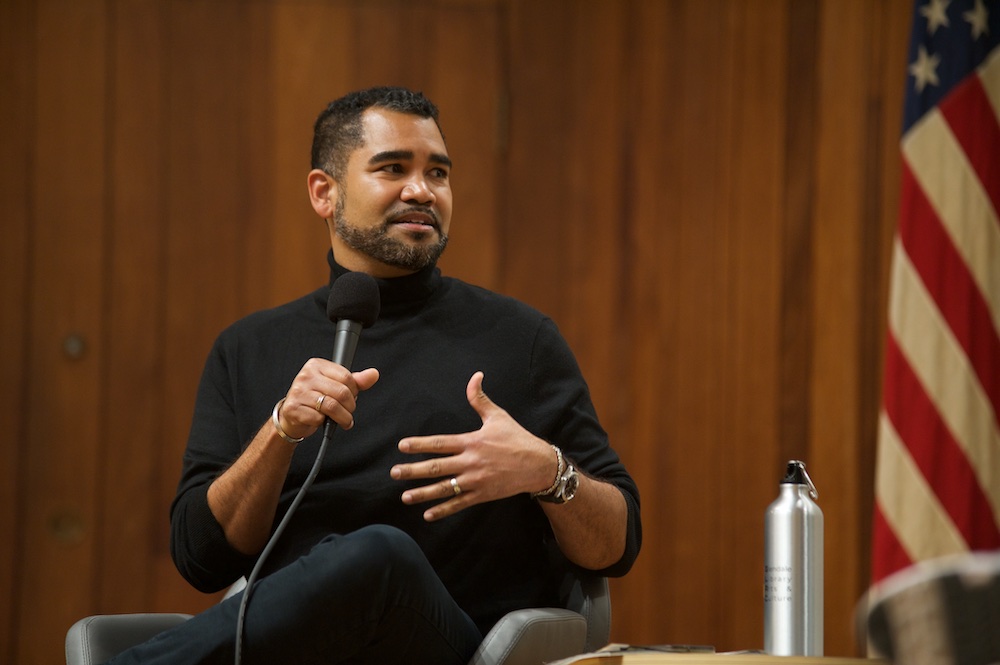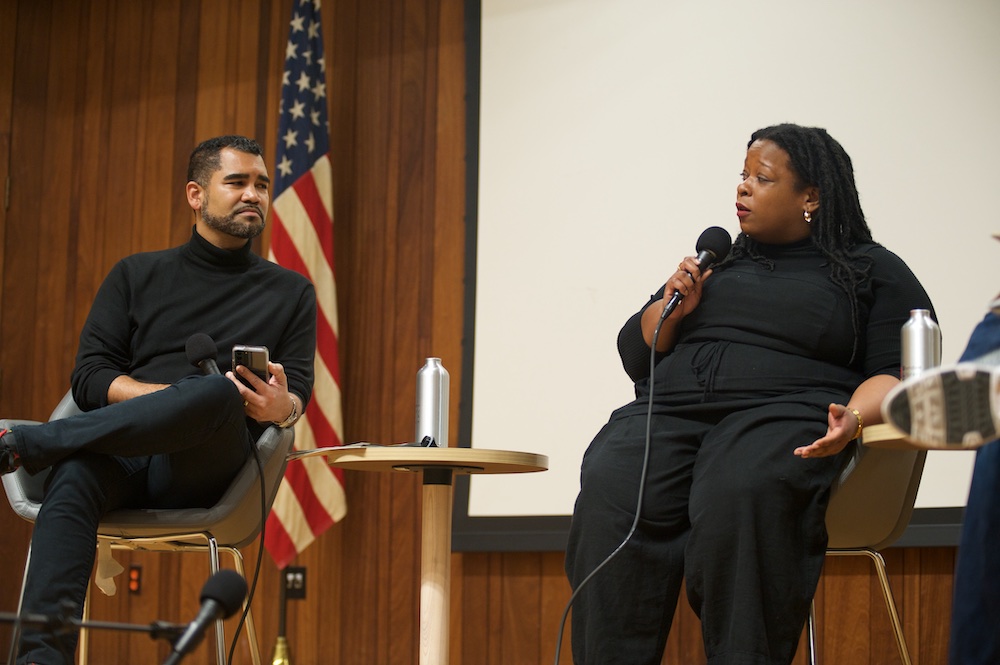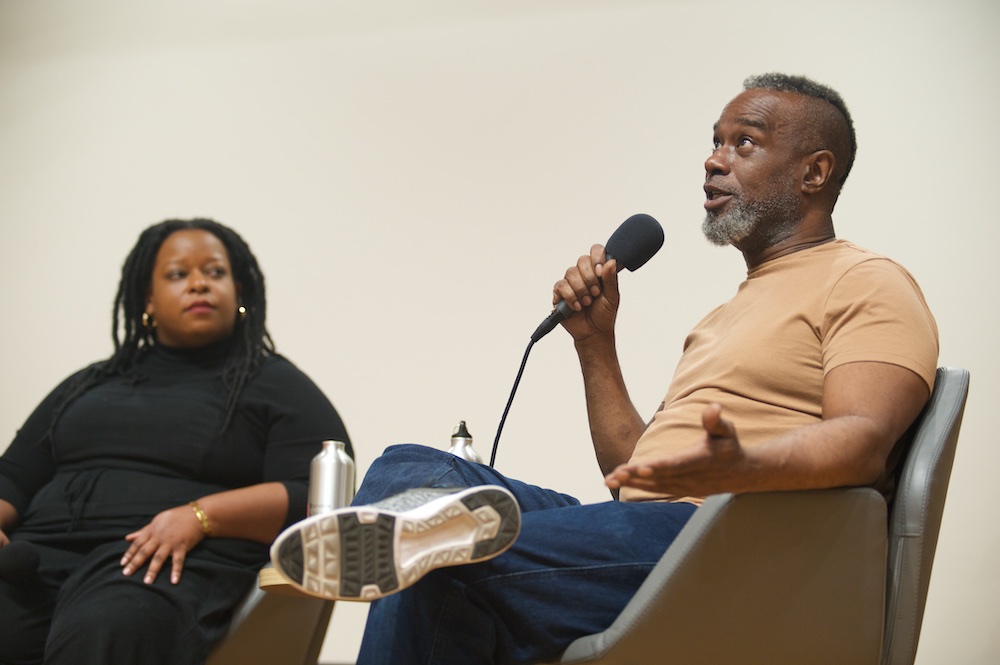Chance the Rapper, the announced headliner of Artillery’s “Black Diaspora Emerging” forum at Glendale Public Library January 28, was sidelined by a sudden illness, disappointing the organizers and many attendees. But even if the “Black Star Line” failed to dock in so-white and far-up-river Glendale, a lively discussion of Black art issues ensued among three panelists, touching on subjects from Basquiat to the multi-national Lakers lineup.
Some of Chance’s current concerns were channeled by Donnell Alexander, journalistic storyteller and cannabis podcaster, who recently interviewed the Grammy-winning Chicago rapper/producer for Artillery’s Jan/Feb ’23 issue. Joining him was interdisciplinary artist Donasia Tillery, winner of MOZAIK’s Future Art Writer’s Award, who touched down lately in Nigeria and Cape Town, taking the pulse of Africa’s art scene. Moderating was Demetri Broxton of San Francisco’s Museum of the African Diaspora, founded in 2005 with a focus on presenting the art and artists of the African diaspora around the globe. MoAD was the first museum in the world to present solo exhibitions for Ghana-born painter Amoako Boafo and Johannesburg-based Billie Zangewa. The museum works in partnerships with similarly focused museums across the US, in Africa and in Europe, Broxton explains, breaking down barriers of access that artists of African descent experience in the art world.

Demetri Broxton at the “Black Diaspora Emerging” panel. Photo by Tyler Hubby.
A central conundrum the panelists wrestled with was the question of what constitutes “blackness” in art – and whether that’s being defined in practice by the Black community or the (largely white) market. Tillery pointed to the obstacles colonialism and slavery imposed on unity of Black vision: “Deprived of culture, of language, of religion, the things that unite people.” Despite these immense challenges, Tillery sees residual bonds in expressions of “emotional experiences you simply can’t have unless you inhabit a black body.”
“It’s important for us to define these things,” Alexander added. “We can’t be dependent on white people. But we’re not that well-travelled—that needs to change, so we make deeper connections.” In some arenas, he pointed out, there’s already cross-border integration, as Afro-German Dennis Schroeder, Sudanese Wenyen Gabriel and Afro-Japanese Rui Hachimura on the Laker squad illustrate. (However, whether this will lead to a wide US audience for Sudanese sports is open to question.)
As Chance pointed out in the interview, the role of marketers and collectors—few of whom are Black—is deeply problematic, especially regarding what’s excluded as insufficiently “Black.” The temporal intersection of the Black Lives Matter uprising and the upsurge of interest in the field centered the political at the expense of the personal. The struggle against various forms of oppression may be central, panelists agreed, but other themes in art—abstraction or family life, for example—should not be devalued or marginalized.

Donasia Tillery at the “Black Diaspora Emerging” panel. Photo by Tyler Hubby.
The politics of Black portraiture is very much in the air, Alexander noted—even a story line on Showtime’s Flatbush Misdemeanors: “Kevin Iso’s character is working on a bucolic landscape with ducks in the foreground, while the folks in control of his fellowship wonder aloud why he’s not painting something ‘authentic’ or ancestral.’” When Black portraitists do have their ducks in the proper row could no doubt have been the subject of a forum in itself. “There’s suppression of the creative drive if you’re always trying to be a teacher,” Tillery added. “It’s dehumanizing to ask people to enact things not relevant to their real personal life.”
Post-2020, the art world has feverishly invested in Black art globally, but especially on the African continent, Broxton told Artillery after the forum. “The contemporary African art market is at an all-time high. The increase in art fairs, such as 1:54 Art Fair, venues like the Zeitz MOCAA in Cape Town, and galleries opening all over the continent, have brought increasing numbers of African Americans to Africa to experience modern and contemporary art by African creatives firsthand. The connecting points are already in place and with more economic support, they will only grow in their influence.”
We asked Broxton if the diaspora was also impacting African culture. “I think rather than the influence being a one-way street, we are seeing… contemporary art from Africa in dialog with Black artists around the world,” he responded. “I would argue that influence is more of a circuit with ideas being exchanged back and forth.”

Demetri Broxton and Donasia Tillery at the “Black Diaspora Emerging” panel. Photo by Tyler Hubby.
In December, Broxton added, Chanel’s Métiers d’Art held its first ever show in Dakar, Senegal. “Having a huge brand like Chanel touch down on African soil and the promise of the fashion giant mentoring and working with Senegalese artisans points to massive future growth in the continent in the world of fashion,” he added.
This is all good for local artisans and Senegal’s economy to be sure. But one wonders if it transcends, or does it reinforce, a culture of colonialism. The underlying question, as posed by Tillery: “Are we seeking access and a seat at the table—or art that’s trying to protect us?” In the discussion period afterward, an activist with the Save Crenshaw coalition posed that query too—“Why isn’t there any art on protecting the community against gentrification?” The discussion of the Black agenda in the arts has been spirited and ongoing—especially since Afro-Francais thinkers from the Caribbean and West Africa launched the Negritude movement in 1937 in Paris to decolonize their cultures—and consensus on such issues will never be reached. But clearly there’s value in deepening the discussion, a worthy subject for a future Artillery forum engaging a broad range of diaspora voices. Odds are Chance should be feeling better.


